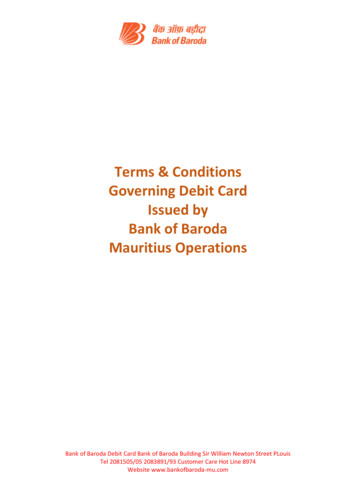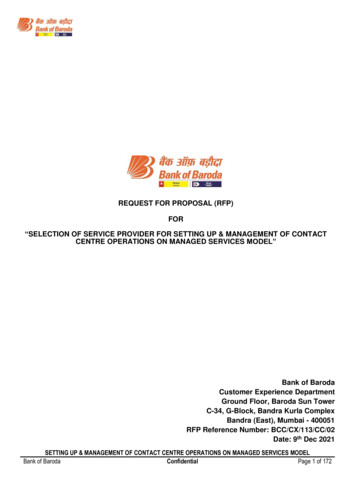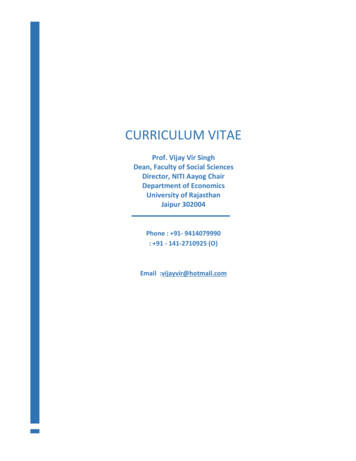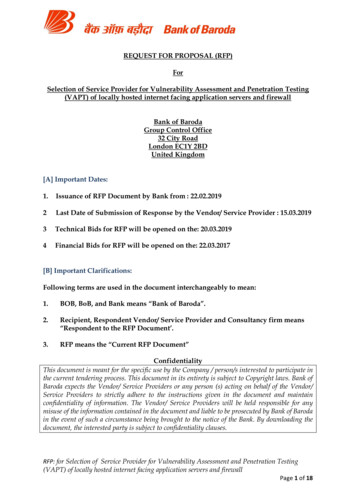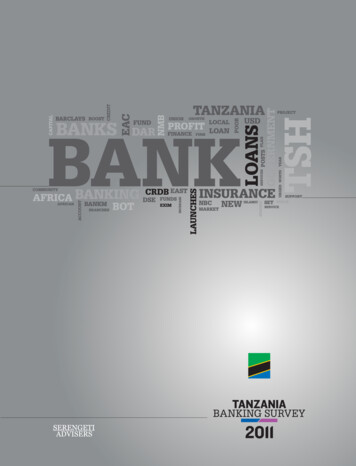
Transcription
Baroda Rajasthan KshetriyaGramin BankPolicy OnKnow Your Customer (KYC) NormsAnti- Money Laundering (AML) StandardsCombating of Financing of Terrorism (CFT)AndObligation of Bank under PMLA, 2002& the Prevention of Money Laundering(Maintenance of Records) Rules, 2005(2020-21)Operation DepartmentHead Office, AjmerPage 1 of 98
INDEXSR.NO.DETAILSPAGENO.55561234PreambleEffective Date of policyPrevious Instruction / circulars Issued by BankScope/Application of the KYC-AML-CFT Policy5Confirmation for compliance of policy Guidelines by Branches andRegional AuthoritiesPolicy ObjectivesDefinitionsKey Elements of KYC- AML- CFT PolicyCustomer Acceptance Policy (CAP). Freezing and closure of accounts Customer ProfileMoney Laundering Risk Categorization Review of Money Laundering Risk Category Due Diligence in customer Accounts Simplified norms for Self Help Groups Procedure to be followed in respect of foreign students Simplified KYC norms for Foreign Portfolio Investors (FPIs) Client accounts opened by professional intermediaries Accounts of Politically Exposed Persons (PEPs) residentoutside India6Customer Identification Procedure (CIP) Unique Customer Identification Code (UCIC) Customer Due Diligence requirements (CDD) while openingof accounts In case of Joint Account of individuals In case of Foreign Students In case of transfer of account from one branch to anotherbranch Accounts of Non- Individuals (Legal Persons / Entities) Beneficial ownership Accounts of companies and firms Accounts of sole proprietary firms/concerns Accounts of Partnership Firm Accounts of an unincorporated association/UnregisteredTrust or body of Individuals/Societies Periodical UpdationSmall AccountMonitoring of TransactionsRisk ManagementIntroduction of New TechnologyCombating Financing of Terrorism (CFT)Watch list Alerts (WL)Requirements/obligations under International AgreementsFreezing of financial assets2023678910111213141516171819Page 2 of 353637434444444445
SR.NO.2021222324DETAILSDesignated Director and Principal OfficerPrevention of Money Laundering (PML) Act, 2002.Reports to be furnished to FIU-IND Cash Transaction Report (CTR) Suspicious Transaction Report (STR) Counterfeit Currency Report (CCR) Non-Profit Organisation Report (NTR)Miscellaneous Secrecy Obligations and Sharing of InformationCDD Procedure and sharing KYC information with Central KYCRecords Registry (CKYCR) Reporting requirement under Foreign Account Tax Compliance Act (FATCA))and Common Reporting Standards (CRS)PAGENO.454952525358585859252627Selling Third party productsAt par cheque facility availed by co-operative banksOperation of bank accounts and “Money Mules”6061622829Walk-in CustomersOther Instructions Correspondent Banking and Shell Banks Issue of Demand Drafts / Bankers Cheques etc. forRs.50,000/- or more Wire TransferGeneral GuidelinesReview of Policy626262633031Page 3 of 98646567
ANNEXURE TO tal KYC ProcessKYC documents for eligible FPIs under PISProcedure for implementation of Section 51- A of the UnlawfulActivities (Prevention) Act, 1967List of valid KYC Documents to be obtained for Account OpeningList of High / Medium / Low Risk Countries.Risk Categorization Table based on Annual Income / TurnoverIndicative List of High / Medium risk customersIndicative List of High / Medium risk Products & ServicesIndicative List of High / Medium Risk GeographiesIndicative list of Behavior Based Alert Indicators for Branches/DepartmentsIndicative list of Alert Indicators for Branches/ DepartmentsCustomer Profile InformationList of Companies/ Individuals identified/ suspected of carrying outMLM activitiesRed Flag Indicators for Trade Based Money Launderingrecommended by FIU-IND Working GroupAbbreviations used in the PolicyAMLROAnti Money Laundering Reporting OfficerBOBeneficial OwnerCAPCustomer Acceptance PolicyCBWTCross Border Wire TransfersCCRCounterfeit Currency ReportCDDCustomer Due DiligenceCFTCombating Financing of TerrorismCIPCustomer Identification ProceduresCTRCash Transaction ReportEDDEnhanced Due DiligenceFATFFinancial Action Task ForceFIU- INDFinancial Intelligence Unit- INDIAFPIForeign Portfolio InvestorsMLMMulti Level MarketingMLROMoney Laundering Reporting OfficerNTRNon Profit Organisation Transaction ReportPEPPolitically Exposed PersonPMLAPrevention of Money Laundering ActPOAPower of AttorneyPOPrincipal OfficerSHGSelf Help GroupSTRSuspicious Transaction ReportUCICUnique Customer Identification CodePage 4 of 98ABCDFF-1F-2F-3F-4F-5Part- IF-5Part- IIGHI
Policy on: Know Your Customer (KYC) norms Anti-Money Laundering (AML) standards Combating of Financing of Terrorism (CFT) measures ANDObligation of Bank under Prevention of Money Laundering Act, (PMLA), 2002 and thePrevention of Money Laundering (Maintenance of Records) Rules,2005.1. Preamble:Our bank’s existing KYC-AML-CFT policy was approved by the Board of Directors on24.09.2013. This policy is to be reviewed in reference of RBI guidelines.In terms of the Guidelines issued by Reserve Bank of India on Know Your Customer (KYC)Standards, Anti Money Laundering (AML) Measures and Combating Financing of Terrorism(CFT), Banks are required to put in place a comprehensive policy frame work covering KYCnorms, AML standards, CFT measures and Obligation of Bank under Prevention of MoneyLaundering Act, (PMLA), 2002 and the Prevention of Money Laundering (Maintenance ofRecords) Rules, 2005.Accordingly, Model policy on KYC norms, AML standards, CFT measures and obligation ofBank under Prevention of Money Laundering Act, (PMLA), 2002 and the Prevention of MoneyLaundering (Maintenance of Records) Rules, 2005 implemented.Reserve Bank of India while issuing guidelines to banks taken into account(i)Provisions / amendments applicable to banks in PML Act 2002,(ii)Recommendations made by the Financial Action Task Force (FATF) on Anti MoneyLaundering (AML) Measures and Combating Financing of Terrorism (CFT) and(iii) Incorporate aspects covered in the paper issued on Customer Due Diligence (CDD) forbanks by the Basel Committee on Banking Supervision with indicative suggestions whereverconsidered 6 dated February 25, 2016 (Updated as on April20, 2020)on Know Your Customer (KYC) Norms / Anti Money Laundering (AML) Standards /Combating Financing of Terrorism (CFT) and obligation of Banks under PMLA 2002,consolidating therein all the instructions / guidelines issued on the subject till 31stJanuary2016.This policy document is therefore prepared keeping in view consolidated guidelines ofReserve Bank of India contained in their Master Direction dated February 25, 2016 andguidelines issued thereafter up to20thAPRIL 2020. It also incorporates Bank’s approach onvarious aspects of compliance framework of KYC-AML-CFT.2. Effective Date of policyThis policy will be known as KYC-AML-CFT Policy of the Bank. It will be effective from thedate it is approved by the Board and will supersede the earlier Policy Guidelines in respect ofKYC norms, AML standards and CFT measures.3. Previous instructions / circulars issued by BankAll relevant instructions/guidelines regarding KYC-AML-CFT issued by Bank are beingincorporated in this policy.Page 5 of 98
4. Scope / Application of the KYC-AML-CFT PolicyThe guidelines contained in this Policy will be applicable to:a. All branches of the bank.b. Prospective / Existing Customer opening / maintaining any type of account.c. Mobile based banking services/Net based Banking Service.These guidelines are to be read in conjunction with related operational guidelines issued fromtime to time. Applicable to existing and prospective customers of the bankWhile bank will apply KYC-AML-CFT norms, standards and procedures prescribed by bank inthis policy to all prospective / new customers, the same would also be applied to all existingcustomers without any exception.The bank will ensure that existing accounts of Individuals, Companies, Firms, Trusts,Charities, Religious Organizations and other institutions are also subjected to KYC-AML-CFTnorms, standards and procedures which would establish the identity of the natural / legalperson and those of the ‘Beneficial Owners’.Similarly, the Bank will ensure that Term / Recurring Deposit Accounts of existing customersare also subjected to KYC norms / procedures at the time of renewal of the deposits if suchcustomers are not maintaining any Savings or Current Account with the bank. However if suchcustomers are maintaining KYC compliant savings or current accounts and their accountshave not become due for updation of their identification data, then their Term / RecurringDeposits will be linked to their KYC Compliant Savings or Current Account by having crossreferences and no KYC Documents would be insisted from them at the time of renewal of theirdeposits with the bank. Applicable to Mobile/Net Based Banking Services offered by bankThese guidelines and amendments therein issued by bank from time to time will also beapplicable to Mobile Based Banking Services offered by bank.Reserve Bank of India has issued guidelines on KYC-AML-CFT to banks under Section 35A ofthe Banking Regulation Act, 1949 and Rule 7 of Prevention of Money-Laundering(Maintenance of Records of the Nature and Value of Transactions, the Procedure and Mannerof Maintaining and Time for Furnishing Information and Verification and Maintenance ofRecords of the Identity of the Clients of the Banking Companies, Financial Institutions andIntermediaries) Rules, 2005. Hence, any contravention thereof or non-compliance by bankshall attract penalties under Banking Regulation Act.5. Confirmation for compliance of policy guidelines by Branches and RegionalAuthoritiesAll Branches will send their confirmation on Monthly basis to their Regional Authorities forhaving complied fully with the KYC–AML-CFT guidelines of the bank while opening newaccounts as well in all existing accounts in the first week of succeeding month and willpreserve record thereof for inspection purpose.All Regional Authorities will also send their confirmation on monthly basis to the ChiefCompliance Officer/Principal Officer of the bank at Head Office for having complied fully withKYC-AML-CFT guidelines of the bank while opening new accounts as well in all old existingaccounts by all their branches in the first week of succeeding month and will preserve recordPage 6 of 98
of monthly confirmations received from branches as well preserve record of monthlyconfirmations sent to the Principal Officer for inspection purpose.6. Policy Objectivesa. To prevent bank from being used, intentionally or unintentionally, by criminal elements forMoney Laundering or Terrorist Financing Activities.b. To enable bank to know / understand their customers and their financial dealings betterwhich in turn help them manage their risks prudently.c. To comply with provisions of Applicable Laws and Regulatory Guidelines.d. To lay down explicit criteria for acceptance of customers.e. To establish procedures for verification of identification of individuals / non-individuals foropening of account.f. To establish process and procedures for monitoring transactions and / or transactions ofsuspicious nature in accounts.g. To put in place appropriate software applications and controls for generations of Alerts anddetection / reporting of suspicious activities in accordance with the Regulatory requirementsand guidelines.h. To create awareness amongst all the staff members through training and other means onKYC-AML-CFT norms, standards and procedures and to provide them clarity on variousaspects for enabling them to implement the Policy in its true spirit.7. Definitions:7.1 CustomerFor the purpose of KYC Norms, a ‘Customer’ is defined as a person or entity that maintain anaccount and/or a business relationship with the Bank. In other words, a person who isengaged in a financial transaction or activity with the Bank and includes a person on whosebehalf the person who is engaged in the transaction or activity, is acting.(Beneficial owner)7.2 PersonIn terms of PML Act a ‘person’ includes:i. an individual,ii. a Hindu undivided family,iii. a company,iv. a firm,v. an association of persons or a body of individuals, whether incorporated or not,vi. every artificial juridical person, not falling within any one of the above persons (i to v), andvii. any agency, office or branch owned or controlled by any of the above persons (i to vi).7.3 Transaction“Transaction” means a purchase, sale, loan, pledge, gift, transfer, delivery or thearrangement thereof and includesa. opening of an account;Page 7 of 98
b. deposits, withdrawal, exchange or transfer of funds in whatever currency, whether in cashor by cheque, payment order or other instruments or by electronic or other non-physicalmeans;c. the use of a safety deposit box or any other form of safe deposit;d. entering into any fiduciary relationship;e. any payment made or received in whole or in part of any contractual or other legalobligation; orf. Establishing or creating a legal person or legal arrangement.7.4 Central KYC Records Registry (CKYCR)“Central KYC Records Registry” (CKYCR) means a central agency i.e. CERSAI to receive,store, safeguard and retrieve the KYC records in digital form of a customer.“Know Your Client(KYC) Identifier” means the unique number or code assigned to a customerby the Central KYC Registry.7.5 KYC Templates“KYC Templates” means templates prepared to facilitate collating and reporting the KYC datato the CKYCR for individuals.7.6 Officially valid document (OVD)“Officially valid document” (OVD) means The passport, The driving licenses, Proof of Possession of Aadhar number, The Voter's Identity Card issued by the Election Commission of India, Job card issued by MGNREGA duly signed by an officer of the State Government, Letter issued by the National Population Register containing details of name, address.Provided that,(a) where the customer submits his proof of possession of Aadhaar number as an OVD, hemay submit it in such form as are issued by the Unique Identification Authority of India.(b) where the OVD furnished by the customer does not have updated address, the followingdocuments or the equivalent e-documents thereof shall be deemed to be OVDs for the limitedpurpose of proof of address:i. Utility bill which is not more than two months old of any service provider (electricity,telephone, post-paid mobile phone, piped gas, water bill);ii. Property or Municipal tax receipt;iii. Pension or family pension payment orders (PPOs) issued to retired employees byGovernment Departments or Public Sector Undertakings, if they contain the address;iv. letter of allotment of accommodation from employer issued by State Government or CentralGovernment Departments, statutory or regulatory bodies, public sector undertakings,scheduled commercial banks, financial institutions and listed companies and leave and licenceagreements with such employers allotting official accommodation;(c) The customer shall submit OVD with current address within a period of three months ofsubmitting the documents specified at ‘b’ abovePage 8 of 98
(d) Where the OVD presented by a foreign national does not contain the details of address, insuch case the documents issued by the Government departments of foreign jurisdictions andletter issued by the Foreign Embassy or Mission in India shall be accepted as proof ofaddress.Explanation: For the purpose of this clause, a document shall be deemed to be an OVD evenif there is a change in the name subsequent to its issuance provided it is supported by amarriage certificate issued by the State Government or Gazette notification, indicating such achange of name.Explanation: Customers, at their option, may submit one of the six OVDs for proof of identityand proof of address. (Except PAN i.e. for proof of identity only)7.7 Principal Officer“Principal Officer” means a designated officer nominated by the Bank who is responsible forfurnishing information as per rule 8 of the PML Rules.(a) The Principal Officer shall be responsible for ensuring compliance, monitoring transactions,and sharing and reporting information as required under the law/regulations.(b) The name, designation and address of the Principal Officer shall be communicated to theFIU-IND. General Manager shall be Principal Officer in our Bank.7.8 Designated Director“Designated Director” means a person designated by the Bank to ensure overall compliancewith the obligations imposed under the Prevention of Money Laundering Amendment Act andthe Rules and shall be nominated by the Board.(a) The name, designation and address of the ‘Designated Director shall be communicated tothe FIU-IND.(b) In no case, the Principal Officer shall be nominated as the “Designated Director”.Chairman will be “Designated Director” in our Bank.7.9 Suspicious transaction“Suspicious transaction” means a “transaction” as defined below, including an attemptedtransaction, whether or not made in cash, which, to a person acting in good faith:a. gives rise to a reasonable ground of suspicion that it may involve proceeds of an offencespecified in the Schedule to the Act, regardless of the value involved; orb. appears to be made in circumstances of unusual or unjustified complexity; orc. appears to not have economic rationale or bona-fide purpose; ord. gives rise to a reasonable ground of suspicion that it may involve financing of the activitiesrelating to terrorism.Explanation: Transaction involving financing of the activities relating to terrorism includestransaction involving funds suspected to be linked or related to, or to be used for terrorism,terrorist acts or by a terrorist, terrorist organization or those who finance or are attempting tofinance terrorism.7.10 Walk-in Customer“Walk-in Customer” means a person who does not have an account based relationship withthe Bank, but undertakes transactions with the Bank.Page 9 of 98
7.11 Customer Due Diligence (CDD)“Customer Due Diligence (CDD)” means identifying and verifying the customer and thebeneficial owner using ‘Officially Valid Documents’ as a ‘proof of identity’ and a ‘proof ofaddress’.7.12 On-going Due Diligence:“On-going Due Diligence” means regular monitoring of transactions in Customer’s accounts toensure that they are consistent with the customers’ profile and source of funds.7.13 Periodic Updation:“Periodic Updation” means steps taken to ensure that documents, data or informationcollected under the CDD process is kept up-to-date and relevant by undertaking reviews ofexisting records at periodicity prescribed by the Reserve Bank of India.7.14 Foreign Account Tax Compliance Act (FATCA)“FATCA” means Foreign Account Tax Compliance Act of the United States of America (USA)which, inter alia, requires foreign financial institutions to report about financial accounts heldby U.S. taxpayers or foreign entities in which U.S. taxpayers hold a substantial ownershipinterest.7.15 Common Reporting Standards (CRS)“Common Reporting Standards” (CRS) means reporting standards set for implementation ofmultilateral agreement signed to automatically exchange information based on Article 6 of theConvention on Mutual Administrative Assistance in Tax Matters.7.16 Inter Governmental Agreement (IGA)“IGA” means Inter Governmental Agreement between the Governments of India and the USAto improve international tax compliance and to implement FATCA of the USA.7.17 Non-face-to-face customers“Non-face-to-face customers” means customers who open accounts without visiting theBank’s Branches/ Offices or meeting the officials of the Bank.7.18 Politically Exposed Persons (PEPs)“Politically Exposed Persons” (PEPs) are individuals who are or have been entrusted withprominent public functions in a foreign country, e.g., Heads of States/Governments, seniorpoliticians, senior government/judicial/ military officers, senior executives of state-ownedcorporations, important political party officials, etc.7.19 Non Profit Organizations (NPO)Non Profit Organizations (NPO) means any entity or organization that is registered as trust ora society under the Societies Registration Act, 1860 or any similar State legislation or acompany registered under Section 8 of the Companies Act, 2013.7.20“Equivalent e-document”“Equivalent e-document” means an electronic equivalent of a document, issued by the issuingauthority of such document with its valid digital signature including documents issued to thedigital locker account of the customer as per rule 9 of the Information TechnologyPage 10 of 98
(Preservation and Retention of Information by Intermediaries Providing Digital LockerFacilities) Rules, 2016.7.21“Certified copy”Obtaining a certified copy by the Bank shall mean comparing the copy of the proof ofpossession of Aadhaar number where offline verification cannot be carried out or officiallyvalid document so produced by the customer with the original and recording the same on thecopy by the authorised officer of the Bank as per the provisions contained in the Act.Provided that in case of Non-Resident Indians (NRIs) and Persons of Indian Origin (PIOs), asdefined in Foreign Exchange Management (Deposit) Regulations, 2016 {FEMA 5(R)},alternatively, the original certified copy, certified by any one of the following, may be obtained: Authorised officials of overseas branches of Scheduled Commercial Banks registered inIndia, Branches of overseas banks with whom Indian banks have relationships, Notary Public abroad, Court Magistrate, Judge, Indian Embassy/Consulate General in the country where the non-resident customer resides.7.22 Beneficial Owner (BO)a. Where the customer is a company, the beneficial owner is the natural person(s), who,whether acting alone or together, or through one or more juridical persons, has/have acontrolling ownership interest or who exercise control through other means.Explanation- For the purpose of this sub-clause “Controlling ownership interest” means ownership of/entitlement to more than 25 per cent ofthe shares or capital or profits of the company. “Control” shall include the right to appoint majority of the directors or to control themanagement or policy decisions including by virtue of their shareholding or managementrights or shareholders agreements or voting agreements.b. Where the customer is a partnership firm, the beneficial owner is the natural person(s),who, whether acting alone or together, or through one or more juridical person, has/haveownership of/entitlement to more than 15 per cent of capital or profits of the partnership.c. Where the customer is an unincorporated association or body of individuals, thebeneficial owner is the natural person(s), who, whether acting alone or together, or throughone or more juridical person, has/have ownership of/entitlement to more than 15 per cent ofthe property or capital or profits of the unincorporated association or body of individuals.Explanation: Term ‘body of individuals’ includes societies. Where no natural person isidentified under (a), (b) or (c) above, the beneficial owner is the relevant natural person whoholds the position of senior managing official.d. Where the customer is a trust, the identification of beneficial owner(s) shall includeidentification of the author of the trust, the trustee, the beneficiaries with 15% or more interestin the trust and any other natural person exercising ultimate effective control over the trustthrough a chain of control or ownership.7.23 Digital KYC“Digital KYC” means the capturing live photo of the customer and officially valid document orthe proof of possession of Aadhaar, where offline verification cannot be carried out, along withPage 11 of 98
the latitude and longitude of the location where such live photo is being taken by an authorisedofficer of the Bank as per the provisions contained in the Act.7.24 Digital Signature“Digital Signature” shall have the same meaning as assigned to it in clause (p) of subsection(1) of section (2) of the Information Technology Act, 2000 (21 of 2000).7.25 Shell bank”“Shell bank” means a bank which is incorporated in a country where it has no physicalpresence and is unaffiliated to any regulated financial group.7.26 “Wire Transfer”“Wire transfer” means a transaction carried out, directly or through a chain of transfers, onbehalf of an originator person (both natural and legal) through a bank by electronic means witha view to making an amount of money available to a beneficiary person at a bank.7.27 “Domestic and cross-border wire transfer”:When the originator bank and the beneficiary bank is the same person or different personlocated in the same country, such a transaction is a domestic wire transfer, and if the‘originator bank’ or ‘beneficiary bank’ is located in different countries such a transaction iscross-border wire transfer.7.28“Video based Customer Identification Process (V-CIP)”:A method of customer identification by an official of the Bank by undertaking seamless,secure, real-time, consent based audio-visual interaction with the customer to obtainidentification information including the documents required for CDD purpose, and to ascertainthe veracity of the information furnished by the customer. Such process shall be treated asface-to-face process for the purpose of this policy.8. Key Elements of KYC-AML-CFT Policya. Customer Acceptance Policy (CAP)b. Customer Identification Procedures (CIP)c. Monitoring of Transactionsd. Risk Management9. Customer Acceptance Policy (CAP)Bank has formulated a clear Customer Acceptance Policy (CAP) by laying down explicitcriteria for acceptance of customers as per RBI guidelines including description of the type ofcustomers that are likely to pose a higher than average risk to the bank. Bank should ensurethe following aspects of customer relationship:a. Bank should not open any account in anonymous or fictitious / benami name(s). i.e. accounton behalf of other persons whose identity have not been disclosed or cannot be verified.b. Bank has clearly defined parameters of risk perception to classify all customers into variousMoney Laundering Risk Categories (MLRC) viz. Low, Medium or High Risk at the time of thePage 12 of 98
opening their accounts. For classifying customers into various Risk Categories, bank hasconsidered following five parameters.1. Country of domicile of the customer and his clients2. Mode of payments3. Type of the customer and nature of the business activity of the customer.4. Annual Income / Turn Over of the customer.5. Social and financial statusCustomers requiring high level of monitoring, e.g. Politically Exposed Persons (PEPs),HNI,Jewelers, Trusts etc. are considered for higher risk classification.Bank will accept customer after verifying their identity as laid down in its CustomerIdentification Procedures (CIP)c. Branches should seek ‘mandatory’ information required for KYC purpose which thecustomer is obliged to give while opening an account or during periodic updation. Other‘optional’ customer details/ additional information, if required, may be obtained separately afterthe account is opened only with the explicit consent of the customer.d. No transaction or account based relationship is undertaken without following the CustomerDue Diligence (CDD) procedure. CDD Procedure is to be followed for all the joint accountholders, while opening a joint account. Further, if an existing KYC compliant customer desiresto open another account with our Bank, she/he need not submit fresh proof of identity and/oraddress. There is no need for a fresh CDD exercisee. Bank will not open an account, where bank is unable to apply appropriate customer duediligence measures i.e. bank is unable to verify the identity and / or obtain documents requiredas per the risk categorization due to non-co-operation of the customer or non-reliability of thedata / information furnished to the bank.f. In case of an existing account where bank is unable to apply appropriate customer duediligence measures i.e. bank is unable to verify the identity and / or obtain documents requiredas per the Risk Categorization due to non-co-operation of the customer or non-reliability of thedata / information furnished to the bank, bank will close the account after following prescribedprocedure. Freezing and closure of accountsi. In case of non-compliance of KYC requirements by the customers despite repeatedreminders, bank will impose ‘partial freezing’ on such KYC non-compliant accounts in aphased manner.ii. During the course of such partial freezing, the account holders can revive their accounts bysubmitting the KYC documents as per instructions in force.iii. While imposing ‘partial freezing’, the bank has to ensure that the option of ‘partial freezing’is exercised only after giving due notice of three months initially to the customers to complywith KYC requirements and to be followed by a reminder giving a further period of threemonths.iv. Thereafter, bank may impose ‘partial freezing’ by allowing all credits and disallowing alldebits with the freedom to close the accounts.Page 13 of 98
v. If the accounts are still KYC non-compliant after six months of imposing initial ‘partialfreezing’, the bank would disallow all debits and credits from/to the accounts thereby,rendering them inoperative.vi. Further, bank would have discretion to close the accounts of such customers after issuingdue notice to the customer explaining the reasons for taking such a decision. Such decisions,however, need to be taken at a reasonably senior level. Branches should, therefore, obtainprior approval from respective Regional Authorities in this regard.vii.When a customer is permitted to act on behalf of another person / entity, bank will ensureto examine circumstances thereof and clearly spell out the same in conf
Our bank's existing KYC-AML-CFT policy was approved by the Board of Directors on 24.09.2013. This policy is to be reviewed in reference of RBI guidelines. In terms of the Guidelines issued by Reserve Bank of India on Know Your Customer (KYC) Standards, Anti Money Laundering (AML) Measures and Combating Financing of Terrorism

